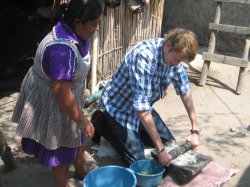Traditional Learning

In most educational systems of today, learner’s are deemed successful when, after receiving information from a teacher, they memorize the information, and then prove that they have the ability to remember it by participating in standardized testing. This is known as didactic learning, which educational writer Paulo Freire describes in this way in his book Pedagogy of the Oppressed:
“Education thus becomes an act of depositing, in which the students are the depositories and the teacher is the depositor... This is the ‘banking’ concept of education, in which the scope of action allowed to the students extends only as far as receiving, filing and storing the deposits... but in the last analysis, it is the people themselves who are filed away through the lack of creativity, transformation, and knowledge in this misguided system” (72).
Didactic learning is a very effective way to produce apathetic, passive people who have the ability to read and write perhaps but have lost the urge to reason, and it has been a method used to educate peoples into assimilated monocultures throughout history.
“Education thus becomes an act of depositing, in which the students are the depositories and the teacher is the depositor... This is the ‘banking’ concept of education, in which the scope of action allowed to the students extends only as far as receiving, filing and storing the deposits... but in the last analysis, it is the people themselves who are filed away through the lack of creativity, transformation, and knowledge in this misguided system” (72).
Didactic learning is a very effective way to produce apathetic, passive people who have the ability to read and write perhaps but have lost the urge to reason, and it has been a method used to educate peoples into assimilated monocultures throughout history.
Experiential Learning

In contrast, experiential learning is the concept that one can learn by involvement in and then reflection on doing. According to Hoover and Whitehead, experiential learning "exists when a personally responsible participant cognitively, affectively, and behaviorally processes knowledge, skills, and/or attitudes in a learning situation characterized by a high level of active involvement" (25). This allows for what Freire calls “problem-posing education” which “is a learning situation in which the cognizable object intermediates the cognitive actors- teacher on the one hand and students on the other... the teacher is no longer the-one-who-teaches, but one who is himself taught in dialogue with the students, who in turn while being taught, also teach” (79-80). Teacher and student work together in hands on situations that require back and forth dialogue and innovative processes. Because of the freedom of expression, which includes emotional reactions as well as cognitive ones, and expectation that the student is able draw their own conclusions, experiential learning has the potential to err if not properly guided. A wheel of learning has been developed to ensure that the experience is reflected on and put to proactive use, rather than just being added to the “bank” of other files.
Our Experience

A number of groups in Mexico have caught on to this, inspired by indigenous traditional teaching methods that have utilized this style of learning for thousands of years. During our time there, we learned through discussion groups, first person accounts, hands on experiences, and reflective journalling. One example of this was being able to learn about the full importance of corn to the rural people of Mexico by first hearing the process of planting, growing, harvesting and selling, and then being able to grind our own corn and make tortillas in the traditional style and eat them. We shared the meal with community members and had a chance to dialogue with them and get to know them. This really gave each of us a multidimensional understanding of the importance of corn not just as a cash crop, but as a food source and most importantly, as something that people come together around and have deep respect for as part of the gift of nature.
Profile: Paulo Freire

Paulo Freire was born in Brazil in 1921. While he was from a middle class family, Freire grew familiar with the poverty that surrounded him during the World Depression in 1929. As a child, he spent time with other children from poor families, a time in his life which he claims had a great impact on his adult world view. He chose to be a secondary school teacher, advocating liberation theology and literacy for all. In 1962, he successfully taught 300 sugarcane workers how to read and write in 45 days. Two years later, when the government was overthrown, Friere was sentenced a traitor due to his beliefs and was imprisoned for just over two months, and then exiled to Bolivia. In 1967, he published Education as the Practice of Freedom, followed by Pedagogy of the Oppressed in 1968.
- adapted from timeline on:
http://www.paulofreireinstitute.org/
- adapted from timeline on:
http://www.paulofreireinstitute.org/
